29+ Amazing Meeting Statistics 2023: Virtual Vs In-Person Meeting, Zoom, And Productivity
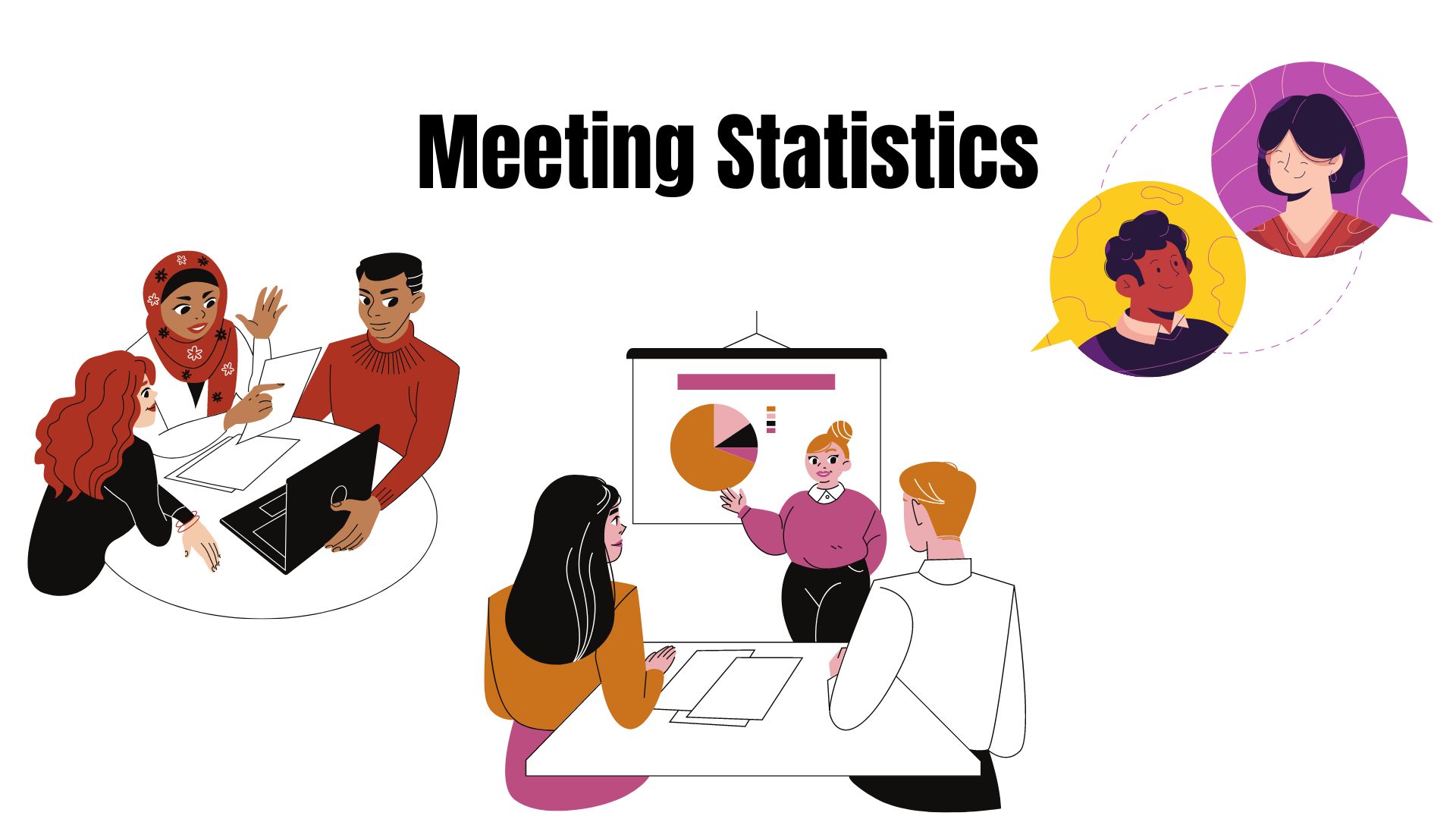
Page Contents
- Top Meeting Statistics for 2023: Editor’s Choice
- Business Meetings Statistics
- Key Elements of Successful Meetings
- Biggest Meeting Irritations Statistics
- Employer Behavior During the Meeting
- Ineffective Meetings Statistics
- Virtual Vs In-Person Meeting Statistics
- Virtual Meeting Statistics
- Facts of Unproductive Meetings
- Meeting Length Breakdown
- Late For Meeting Statistics
- Conclusion
Meeting Statistics: The number of meetings people attend has been consistently increasing over the past 20 years. Unfortunately, they have now become the stuff of nightmares for many workers. Meetings are often described as boring, time-wasting, and unproductive. These Meeting statistics can help you avoid the pitfalls of these dreadful events and make them great again.
Top Meeting Statistics for 2023: Editor’s Choice
- A survey showed that 48% of respondents said they attended meetings multiple times per week.
- Over the past 20 years, the amount of time spent in meetings has increased.
- According to executives, 45% of meetings are pointless.
- The majority of meetings by 74.5% last for 60 minutes in 2023.
- On the other hand, the meeting lasted for 15 minutes said by 13.5% people, other 19.2% spent 15-30 minutes, 41.8% spent meeting timing between 30 minutes to 60 minutes, and 22.5% agreed that the meeting lasted for 2 hours.
- In the United States, the annual loss of unproductive meetings costs $37 billion.
- Employees and managers 71% considered meetings as a waste of time.
- Meetings are termed as productive uses claimed by 17% of senior managers.
- In the United States in 2023, per day there are 55 million meetings take place.
- Fewer than 40% of meeting attendees fall asleep during meetings.
- Time spent in meetings stats show that 67% of meetings fail.
- 75% of CEOs believe that audio-only conferences are a thing of the past.
- Video conferences can increase productivity by 89%.
- Seven out of ten employees feel that their time is being wasted.
- Zoom meeting participants have increased 20-fold.
- Video conferencing has seen a boom due to the COVID-19 pandemic.
Business Meetings Statistics
#1. A survey showed that 48% of respondents said they attended meetings multiple times per week.
The results of a survey that surveyed more than 1,300 individuals about their workplace meetings revealed some fascinating insights. Around 48% of respondents said they attended meetings multiple times per week, followed by 29% of people who said they participated in a meeting every single day. Only 2% of respondents said they had less than one meeting each month.
As of 2023, video calling tools are going to be purchased by 83% of large companies.
In the same year, in-person meetings remained highest in the North American region resulting in 60% of the total number of corporate organized events
#2. Over the past 20 years, the amount of time spent in meetings has increased.
The average time spent in meetings has increased by 10% each year since the advent of this millennium. The typical length of a meeting is between 31 and an hour. Even though adhering to an agenda can cut meeting time by as much as 80%, just 37% of meetings in the United States use agendas.
#3. According to executives, 45% of meetings are pointless.
People don't like wasting their time. Productive meetings for staff need to be agenda-driven, and everyone's responsibilities should be clearly stated before the meeting begins.
#4. One of the well-known facts about the meeting is that the least preferred day for meetings is Monday.
Monday blues are a real thing. Over half of the 47% of participants in a poll have portrayed Mondays as the worst days for meetings, closely followed by Fridays, which garnered 40% of votes.
Meeting days appear to be less effective at the start and end of the workweek. However, meeting stats show that Tuesdays and Wednesdays are the most popular days for meetings. Tuesdays received 29% of the votes for the most popular meeting day and the best timing is 2:30 p.m., with Wednesdays coming in second with 25%.
#5. A mere half of those who attend poorly organized meetings end up more confused.
Meeting research shows that incompetent organizations can have serious consequences. 43% of respondents said they felt more confused after inefficiently organized meetings. 44% of respondents claimed that ineffective meetings prevented them from finishing the rest of their work. Additionally, too many attendees may hinder productivity; according to 31% of respondents, unimportant attendees considerably slowed down work.
#6. Meetings that adhere to the “two pizza rule” are more fruitful.
According to workplace meetings stats, meetings with fewer attendees typically result in higher productivity. Amazon’s CEO Jeff Bezos was again in the spotlight thanks to his “two pizza rule.” This means that no meeting should ever be held in a space where two pizzas wouldn't be enough to feed everyone.
Key Elements of Successful Meetings
The key elements are followed by setting clear objectives by 72%, having a clear agenda (67%), reducing number of people (35%), and visual stimulus (27%).
Biggest Meeting Irritations Statistics
It is interesting to note that the number of meetings does not make a difference in the quality of meetings. Audio and video problems are more serious headaches and can affect the quality of meetings.
#7. Here's what professionals consider the most irritating aspects of meetings:
55%: consider making phone calls or sending texts the most annoying.
50%: People who interrupt others.
50%: Audio-related issues
49%: Arrive late or leave early.
49%: People who aren't open to listening to others.
46%: People who talk for long periods about nothing.
34%: It is difficult to read the room
31%: video quality issues.
28%: Too many meetings.
(Source: Booqed.com)
Employer Behavior During the Meeting
Thus 96% of employees have missed meetings in 2023, and within meetings, 91% of employees have daydreamed.
Furthermore, other employees’ behaviors are followed by doing other work during meetings (73%), complaining that meetings are the #1 time-waster (47%), feeling overwhelmed by continuous meetings (45%) and sleeping during meetings (39%).
Ineffective Meetings Statistics
#8. Fewer than 39% of meeting attendees fall asleep during meetings.
Do you have a bad day? Need a nap? Your best option could be to attend a conference. We have already established that most meetings are a waste of time, but the following information may surprise you: 39% of meeting attendees admitted to falling asleep during meetings.
#9. Seven out of ten workers believe that their time is being wasted.
A startling 71% of professionals say their time was wasted due to canceled or unnecessary meetings. According to wasting time at work stats, around 31 hours of work time is wasted each month on unproductive meetings. Regular employees squander nearly 3 days and 2 hours each year waiting for meetings to begin, and executives waste a great 5 days and 19 hours each year.
#10. Time spent in meetings statistics show that 67% of meetings fail.
Every year, vast amounts of money are spent on unproductive meetings. More specifically, the cost of terrible meetings is over $37 billion annually, while 15% of the company's time is spent on meetings. These stats become especially concerning given that most meetings are unproductive. According to executives, a startling 67% of meetings are a failure.
#11. Searching for an appropriate meeting room is a significant time-waster.
Time does not wait for anyone, and this is true in the business world as well. The meeting room stats show that around 40% of employees waste more than 30 minutes looking for a suitable meeting room.
#12. The majority of workers multitask during a meeting.
If you believe that multitasking is beneficial, you should reconsider. Employees are attending more meetings today than ever, and multitasking can ruin all your efforts to organize a meeting. An astonishing 92% of employees confessed to multitasking during meetings, 69% admitted to checking email, and 49% were doing other unrelated things.
Virtual Vs In-Person Meeting Statistics
Many workers have also been able to work remotely since the COVID-19 Pandemic. This brings with it a new set of challenges, including tech issues and an excessive amount of Zoom phone calls.
By the end of 2025 in the United States around 36.2 million employees are going to be remote workers.
Here are our findings:
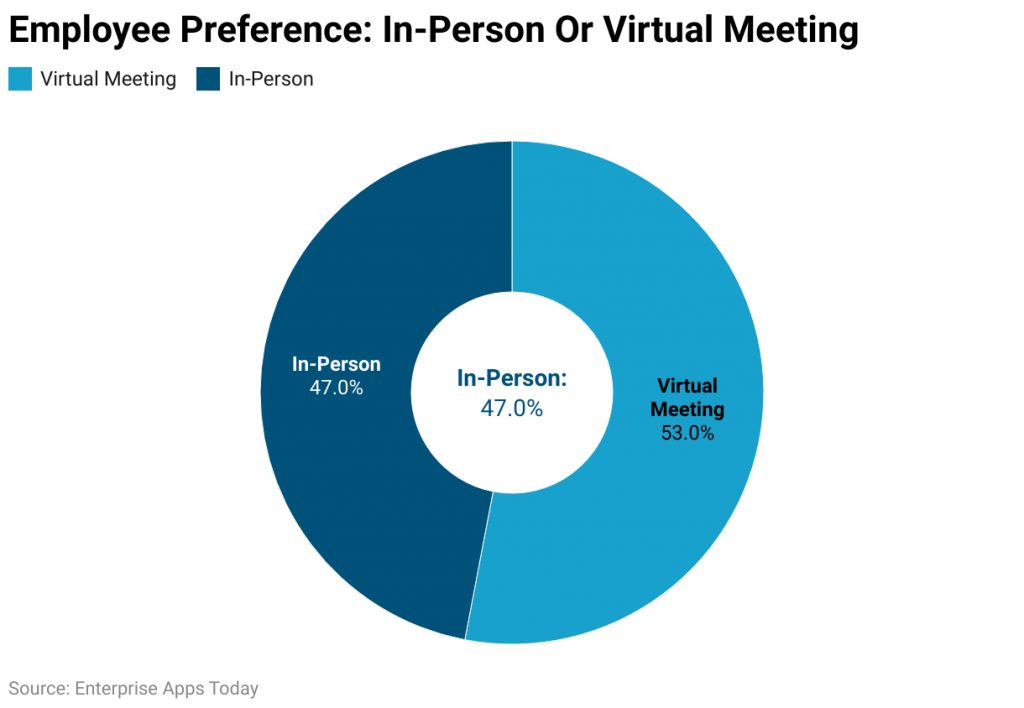
#13. Half of all employees have participated in at least one to three virtual meetings per week since the launch of COVID-19.
Although this is a lower average than in-person meetings it still has its problems. Many remote employees are frustrated with the time lost due to late starting or technical issues. Just under half of them complain about both.
#14. 73% more workers prefer in-person meetings.
This is quite remarkable, given the fact that 90% of Americans prefer fewer meetings at work.
#15. More than 55% of remote employees believe that most meetings “could have been an email.”
And among employees, this is simply the biggest pet annoyance. Other annoyances include- unprepared individuals, people with loud background noises, and off-topic conversations.
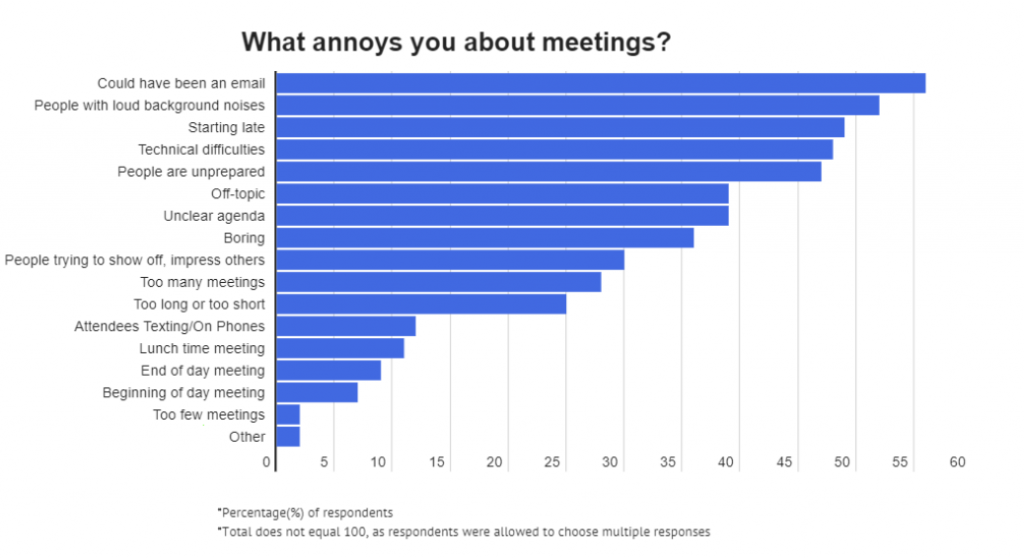
(Source: Zippia.com)
Virtual Meeting Statistics
#16. The COVID-19 pandemic has been linked to an increase in video conferencing.
The need for remote work is growing rapidly, and this year has seen a boom in the video conference industry. The virtual meetings statistics show a 500% rise in buyer activity after the coronavirus disease pandemic. This is also evident in the surge in corporate spending, with around 67% of companies having increased their video conferencing budgets for 2020.
#17. Employee meetings have increased by 15% in 2023.
This is because there are more online meetings than in-person meetings. However, just because more people attend meetings doesn't necessarily mean they are going on longer.
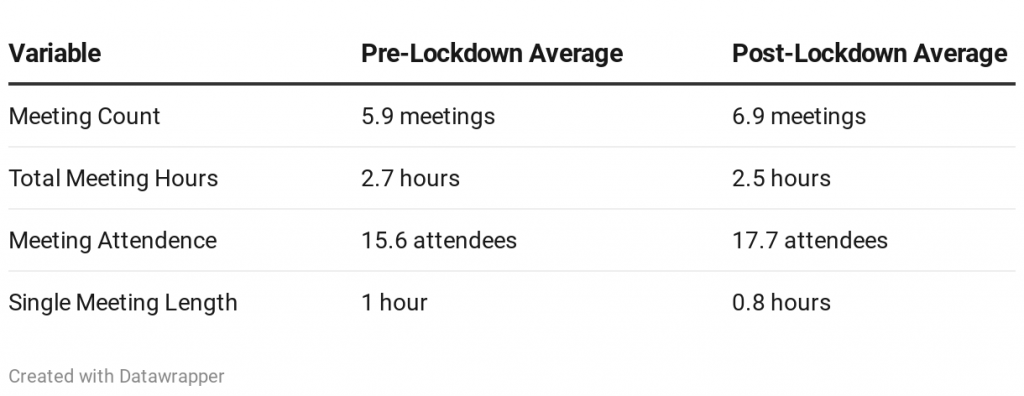
#18. For video meetings, desktop PCs and laptops are essential.
77% of participants connect to video conferences using a laptop or desktop computer in 2023. Smartphones take the second position, with roughly 31% of attendees choosing smartphones as their primary method of communication. Tablets appear to be the least preferred option, selected by only 13% of responders.
#19. Video conferences substantially improve focus.
Participants in meetings are much less prone to multitask while on video calls. Just 4% of workers admitted to multitasking during a video conference. This compares to 57% of employees who admitted to multitasking on a phone call.
#20. 75% of CEOs believe that audio-only conferences are a thing of the past.
The era of this antiquated technology is over. According to meeting stats, three out of four (or 75%) CEOs think that audio-only calls will be totally replaced by video conference calls. Remote attendees simply don't feel interested and find it challenging to participate in a meeting. This is mainly caused by the absence of body language, which makes a significant (80%) contribution to our understanding of the messages we get.
#21. Participants in Zoom meetings have multiplied 20-fold in number.
With COVID-19 spreading and the demand for remote work soaring, many businesses decided to put their faith in Zoom by 10 million daily participants. The number of participants in daily meetings rose from 300 million daily meeting participants in 2023.
#22. Almost 90% of respondents think that video conferences boost productivity.
According to statistics on virtual meetings, an overwhelming majority of respondents (89%) think that video conferences can speed up project completion time.
#23. The global video conferencing market is anticipated to see a CAGR of 11.45% between the years 2020 to 2026.
The global video conferencing market’s worth climbed from $8.5 billion in 2023. That represents a 36% rise in value.
On the other hand, by the end of 2027, the market of video conferencing is going to reach $19.1 billion.
#24. Technology advancements increase engagement.
Video conferencing statistics show that 41% of users believe video conferencing has increased team member engagement. In addition, 35% of users feel that video conference makes them feel more connected to the company's culture.
Facts of Unproductive Meetings
As of 2023, the top factor of unproductive meetings is lack of participant preparation (28%).
Furthermore, other factors are followed by no follow-up on tasks (25%), poor communication (20%), time allocation is not observed (17%), and no minutes (13%).
Meeting Length Breakdown
When it comes to meetings, there is always the question of how long they should be. While there is no magic number, there are some general guidelines that can help ensure your meetings are productive and efficient.
If you're like most people, you've probably struggled to stay focused during a long meeting. You're not alone. A study of 2,000 workers found that the average person can only focus for about 52 minutes before losing concentration.
The study also found that workers felt the most productive when meetings lasted no longer than 30 minutes. So, if you're leading a meeting, try to keep it short and sweet. And if you're attending a meeting, speak up if it starts to drag on.
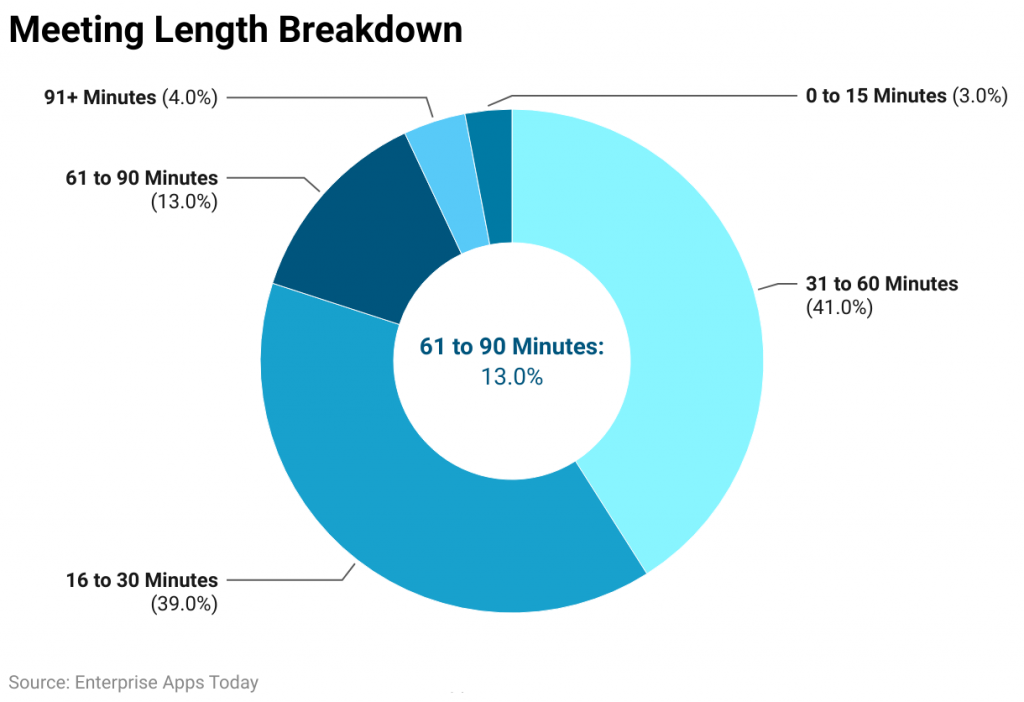
#25. 41% of meetings duration is 31 to 60 minutes.
The average meeting duration is 31 to 60 minutes, according to a new study. The findings show that the average meeting is just over 40 minutes long and that 41 percent of meetings run 31 to 60 minutes in duration.
#26. Only 3% of meetings have a duration of between 10 to 15 minutes.
According to recent research other meeting length breakdowns are followed by 39% of meetings (16 to 30 minutes), 13% (61 to 90 minutes), and 4% (61 to 90 minutes).
Late For Meeting Statistics
#27. Businesses experience a severe financial burden as a result of meeting lateness.
There are too many meetings. This seems to be the increasing sentiment in the modern workforce. Every day, 11 million meetings are held in the United States, 37% of which begin late, and it has previously been shown that being late reduces productivity. Meeting lateness is a significant cause of ineffective meetings costing the US $37 billion.
#28. Individuals' perceptions of tardiness can vary significantly.
Rogelberg and his team's study with 665 individuals revealed that lateness is a vague and elusive concept. According to meeting statistics on lateness, only a fifth of meeting individuals described tardiness as showing up after the scheduled start time. Another 20% permitted a specific “grace” period before they considered someone as late. Surprisingly, just 3% of respondents believed that unpunctuality was a lack of preparation for the actual meeting.
#29. A decline in productivity has been associated with tardiness.
To put this into perspective, a startling 37% of meetings begin after the scheduled time. Frankly, not being punctual is simply impolite. Other people's time is wasted, and those who must wait for the latecomer have unpleasant feelings as a result. According to productivity stats in the workplace, people feel upset, frustrated, and disregarded, which can negatively impact meeting effectiveness.
Conclusion
Meetings are a necessary evil; hopefully, these statistics will help you get the most out of it. Now you have all the information needed to win this battle. Reduce the number of meetings and make them more interactive.
We believe that meetings are an unfortunate but necessary evil. Now you have all the information needed to win this battle. These statistics can help you make the most out of them. You can reduce the number of meetings and make them more interactive. Make your meetings more productive and brighter for the future by shining a light on change.
Sources
FAQ.
According to research on meeting duration, a typical business meeting lasts between 31 and an hour.
The best way to reduce the number of status update meetings is to invest in collaboration or project management software. You could introduce a new concept on a meeting-free day, which is relatively self-explanatory.
Meeting statistics show that most meetings don't produce results. There are many reasons for this inefficiency, and executive agree that around 37% of the meetings are ineffective and fail to bring any value to the firm.
There isn't a consensus about the optimal time to spend in meetings. The rule of thumb is that you should not spend more than 20% of your work time in meetings, regardless of your position in the organization.
As unbelievable as it may seem, 11 million meetings are held daily in the United States, according to statistics on time spent in meetings.
Everything should be done in moderation, and meetings are no exception. Employees who are required to attend too many meetings will undoubtedly lead to losing focus, have less time for "deep thinking," and reduce productivity and performance.
Two days' prior notice is required for scheduling meetings. This gives you enough time to prepare thoroughly and effectively. Additionally, it shows that you value other people's time.
Scheduling a meeting can be a challenging task. According to meeting statistics, it should not be too early in the morning or too late in the afternoon. According to science, Tuesday at 2:30 PM is the best day for scheduling a meeting.
A meeting's failure could be caused by various things, but the main suspects are a lack of an agenda and ineffective time management. Lack of good planning combined with the absence of a clearly defined aim is a formula for disaster.
Tuesdays and Wednesdays are the ideal meeting days, according to meeting statistics. The second day of the week was preferred by 29% of workers, while the neighboring day got 25% of the votes.

Barry is a lover of everything technology. Figuring out how the software works and creating content to shed more light on the value it offers users is his favorite pastime. When not evaluating apps or programs, he's busy trying out new healthy recipes, doing yoga, meditating, or taking nature walks with his little one.